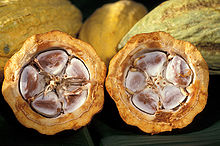Antioxidant effect of polyphenols and natural phenols

A polyphenol antioxidant is a
Sources of polyphenols
The main source of polyphenols is dietary, since they are found in a wide array of
Biochemical theory
The regulation theory considers a polyphenolic ability to scavenge
The “deactivation” of oxidant species by polyphenolic antioxidants (POH) is based, with regard to food systems that are deteriorated by peroxyl radicals (R•), on the donation of hydrogen, which interrupts chain reactions:
- R• + PhOH → R-H + PhO•
Phenoxyl radicals (PO•) generated according to this reaction may be stabilized through
- PhO• + PhO•→ PhO-OPh [7]
Potential biological consequences

Consuming dietary polyphenols have been evaluated for biological activity in vitro, but there is no evidence from high-quality clinical research as of 2015[update] that they have effects in vivo.[1] Preliminary research has been conducted and regulatory status was reviewed in 2009 by the U.S. Food and Drug Administration (FDA).:[6]
- Inflammation such as in coronary artery disease.[8]
- Other possible effects may result from consumption of foods rich in polyphenols, but are not yet proved scientifically in humans, so are not allowed as health statements by the FDA.[6]
Difficulty in analyzing effects of specific chemicals

It is difficult to evaluate the physiological effects of specific natural phenolic antioxidants, since such a large number of individual compounds may occur even in a single food and their fate in vivo cannot be measured.[1][6][9]
Other more detailed chemical research has elucidated the difficulty of isolating individual phenolics. Because significant variation in phenolic content occurs among various brands of tea, there are possible
Practical aspects of dietary polyphenols

There is debate regarding the total body absorption of dietary intake of polyphenolic compounds. While some indicate potential health effects of certain specific polyphenols, most studies demonstrate low bioavailability and rapid excretion of polyphenols, indicating their potential roles only in small concentrations in vivo.[1][2][3][4] More research is needed to understand the interactions between a variety of these chemicals acting in concert within the human body.[1]
Topical application of polyphenols
There is no substantial evidence that reactive oxygen species play a role in the process of skin
Combination of antioxidants in vitro
Experiments on
Antioxidant levels of purified anthocyanin extracts were much higher than expected from anthocyanin content indicating synergistic effect of anthocyanin mixtures.[14]
Antioxidant capacity tests
- Oxygen radical absorbance capacity (ORAC)[11]
- Ferricyanide reducing power
- 2,2-diphenyl-1-picrylhydrazyl radical scavenging activity[15]
See also
- List of phytochemicals in food
- List of antioxidants in food
- Health effects of polyphenols
- Free-radical theory
- Nitric oxide
- Resveratrol
- Astaxanthin
References
- ^ a b c d e f g h i j "Flavonoids". Corvallis, OR: Micronutrient Information Center, Linus Pauling Institute, Oregon State University. November 2015. Retrieved 31 January 2018.
- ^ PMID 15019969.
- ^ a b c d Frei B (April 1, 2009). "Controversy: What are the true biological functions of superfruit antioxidants?". Natural Products Information Center. Archived from the original on March 6, 2010.
- ^ PMID 18762244.
- PMID 28106822.
- ^ a b c d Gross, Paul (1 March 2009), New Roles for Polyphenols. A 3-Part Report on Current Regulations and the State of Science, Nutraceuticals World
- PMID 2172711.
- PMID 8597666.
- PMID 23017782.
- ^ C. Fajardo-Lirai, S. M. Henning, H. W. Lee, V. L. W. Go, and D. Heber,. Department Family Environmental Sciences/Nutrition, Dietetics & Food Science, California State University, Northridge and, UCLA Center for Human Nutrition, Session 46C, 2002 Annual meeting of Food Expo, Anaheim, Ca
- ^ a b "Withdrawn: Oxygen Radical Absorbance Capacity (ORAC) of Selected Foods, Release 2 (2010)". United States Department of Agriculture, Agricultural Research Service. 16 May 2012. Retrieved 31 January 2018.
- S2CID 19659324.
- S2CID 86810404.
- PMID 12358498.
- PMID 18035361.
